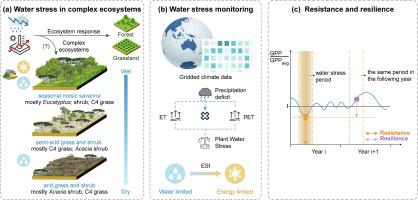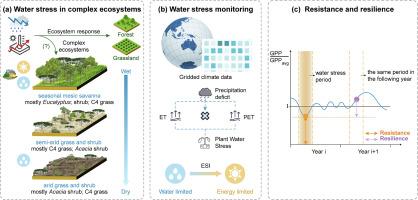卫星观测揭示了澳大利亚沿降雨梯度的优势植被对短期水资源压力的抵抗力和恢复力
IF 11.4
1区 地球科学
Q1 ENVIRONMENTAL SCIENCES
引用次数: 0
摘要
预计气候变化将加剧许多生态系统的水资源压力,并对其稳定性构成威胁,这可以通过生态系统的抵抗力和复原力来量化。相关研究主要集中于多年或年度干旱,以及空间同质或物种特异性生态系统。然而,在复杂的生态系统中,不同的植物表现出不同的适应和恢复行为,对恢复力和抗性的了解较少。利用卫星获得的GOSIF(全球轨道碳观测-2太阳诱导荧光)和通量塔的生产力数据,我们研究了2000年至2018年北澳大利亚热带样带植被对短期(<;1年)水胁迫事件的响应,该样带跨越1600毫米降雨梯度,从季节性mesic到非季节性干旱生态系统过渡。我们将阻力定义为压力期间相对于多年平均基线保持的生产力,而弹性定义为压力后一年相对于相同基线恢复的生产力的程度。结果表明:半干旱区生态系统对水分胁迫的抵抗能力最低,干旱区和半干旱区生态系统对水分胁迫的抵抗能力较高,而生态系统的恢复能力则相反。这些空间格局与季节无关,主要与优势植被类型有关。以木本稀树草原为主的中荒漠地区表现出最高的抗逆性(0.82±0.13,p < 0.001)和最低的抗逆性(0.26±0.19,p < 0.001),干旱区灌丛地表现出中等的抗逆性(0.81±0.14,p < 0.001)和最低的抗逆性(0.27±0.22,p < 0.001),半干旱区草原表现出低的抗逆性(0.78±0.15,p < 0.001)和高的抗逆性(0.38±0.24,p < 0.001)。完全恢复(即一年后超过基线)的最高可能性(75.0%)发生在湿润季节,可能是由于能量限制,而干旱地区的可能性较低(57.0%)。本研究为量化生态系统在水分胁迫下的抗性和恢复力提供了一个遥感框架。本文章由计算机程序翻译,如有差异,请以英文原文为准。


Satellite observations reveal ecosystem resistance and resilience to short-term water stress driven by dominant vegetation along a rainfall gradient in Australia
Climate change is projected to intensify water stress in many ecosystems and poses threats to their stability, which can be quantified through ecosystem resistance and resilience. Relevant studies mostly focused on multi-year or annual droughts, and in spatially homogeneous or species-specific ecosystems. However, resilience and resistance within complex ecosystems, where different plants exhibit different adaptations and recovery behaviours, are less understood. Using productivity data from satellite-derived GOSIF (Global Orbiting Carbon Observatory-2 Solar-Induced Fluorescence) and flux towers, we examined vegetation responses to short-term (<1 year) water stress events from 2000 to 2018 along the North Australia Tropical Transect, which spans a 1600 mm rainfall gradient and transitions from seasonal mesic to non-seasonal arid ecosystems. We define resistance as productivity maintained during stress relative to a multi-year average baseline, and resilience as the extent to which productivity recovered one year after stress relative to the same baseline. Our results show that ecosystem resistance to water stress was lowest in semi-arid regions but higher in both arid and mesic regions, while ecosystem resilience showed the opposite pattern. These spatial patterns occurred regardless of seasonality and were mainly associated with dominant vegetation type. Woody savanna-dominated mesic regions exhibited highest resistance (0.82 ± 0.13, p < 0.001) and lowest resilience (0.26 ± 0.19, p < 0.001), shrublands in arid areas had intermediate values of both resistance (0.81 ± 0.14, p < 0.001) and resilience (0.27 ± 0.22, p < 0.001), while the grasslands in semi-arid regions had low resistance (0.78 ± 0.15, p < 0.001) and high resilience (0.38 ± 0.24, p < 0.001). The highest likelihood (>75.0 %) of full recovery (i.e., exceeding baseline after one year) occurred during the wet season in mesic regions, likely due to energy limitation, while arid regions showed a lower likelihood (57.0 %). This study provides a remote sensing framework for quantifying ecosystem resistance and resilience under water stress.
求助全文
通过发布文献求助,成功后即可免费获取论文全文。
去求助
来源期刊

Remote Sensing of Environment
环境科学-成像科学与照相技术
CiteScore
25.10
自引率
8.90%
发文量
455
审稿时长
53 days
期刊介绍:
Remote Sensing of Environment (RSE) serves the Earth observation community by disseminating results on the theory, science, applications, and technology that contribute to advancing the field of remote sensing. With a thoroughly interdisciplinary approach, RSE encompasses terrestrial, oceanic, and atmospheric sensing.
The journal emphasizes biophysical and quantitative approaches to remote sensing at local to global scales, covering a diverse range of applications and techniques.
RSE serves as a vital platform for the exchange of knowledge and advancements in the dynamic field of remote sensing.
 求助内容:
求助内容: 应助结果提醒方式:
应助结果提醒方式:


